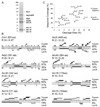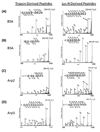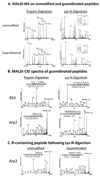Integrating Lys-N proteolysis and N-terminal guanidination for improved fragmentation and relative quantification of singly-charged ions
- PMID: 20207164
- PMCID: PMC2873099
- DOI: 10.1016/j.jasms.2010.02.004
Integrating Lys-N proteolysis and N-terminal guanidination for improved fragmentation and relative quantification of singly-charged ions
Abstract
The study of isolated protein complexes has greatly benefited from recent advances in mass spectrometry instrumentation and quantitative, isotope labeling techniques. The comprehensive characterization of protein complex components and quantification of their relative abundance relies heavily upon maximizing protein and peptide sequence information obtained from MS and tandem MS studies. Recent work has shown that using a metalloendopeptidase, Lys-N, for proteomic analysis of biological protein mixtures produces complementary protein sequence information compared with trypsin digestion alone. Here, we have investigated the suitability of Lys-N proteolysis for use with MALDI mass spectrometry to characterize the yeast Arp2 complex and E. coli PAP I protein interactions. Although Lys-N digestion resulted in an average decrease in protein sequence coverage of approximately 30% compared with trypsin digestion, CID analysis of singly-charged Lys-N peptides yielded a more extensive b-ions series compared with complementary tryptic peptides. Taking advantage of this improved fragmentation pattern, we utilized differential (15)N/(14)N guanidination of Lys-N peptides and MALDI-MS/MS analysis to relatively quantify the changes in PAP I associations due to deletion of sprE, previously shown to regulate PAP I-dependent polyadenylation. Overall, this Lys-N/guanidination integrative approach is applicable for functional proteomic studies utilizing MALDI mass spectrometry analysis, as it provides an effective and economical mean for relative quantification of proteins in conjunction with increased sensitivity of detection and fragmentation efficiency.
Copyright 2010 American Society for Mass Spectrometry. Published by Elsevier Inc. All rights reserved.
Figures




Similar articles
-
Peptides quantification by liquid chromatography with matrix-assisted laser desorption/ionization and selected reaction monitoring detection.J Proteome Res. 2012 Oct 5;11(10):4972-82. doi: 10.1021/pr300514u. Epub 2012 Aug 31. J Proteome Res. 2012. PMID: 22897511
-
Sequencing Lys-N proteolytic peptides by ESI and MALDI tandem mass spectrometry.J Am Soc Mass Spectrom. 2011 Feb;22(2):265-79. doi: 10.1007/s13361-010-0022-7. Epub 2011 Jan 22. J Am Soc Mass Spectrom. 2011. PMID: 21472586
-
Differential dimethyl labeling of N-termini of peptides after guanidination for proteome analysis.J Proteome Res. 2005 Nov-Dec;4(6):2099-108. doi: 10.1021/pr050215d. J Proteome Res. 2005. PMID: 16335955
-
Effect of chemical modifications on peptide fragmentation behavior upon electron transfer induced dissociation.Anal Chem. 2009 Sep 15;81(18):7814-22. doi: 10.1021/ac901108g. Anal Chem. 2009. PMID: 19689115
-
Applications of Tandem Mass Spectrometry (MS/MS) in Protein Analysis for Biomedical Research.Molecules. 2022 Apr 8;27(8):2411. doi: 10.3390/molecules27082411. Molecules. 2022. PMID: 35458608 Free PMC article. Review.
Cited by
-
Proteomics-based methods for discovery, quantification, and validation of protein-protein interactions.Anal Chem. 2013 Jan 15;85(2):749-68. doi: 10.1021/ac3033257. Epub 2012 Dec 12. Anal Chem. 2013. PMID: 23157382 Free PMC article. Review. No abstract available.
-
Interrogating the Venom of the Viperid Snake Sistrurus catenatus edwardsii by a Combined Approach of Electrospray and MALDI Mass Spectrometry.PLoS One. 2015 May 8;10(5):e0092091. doi: 10.1371/journal.pone.0092091. eCollection 2015. PLoS One. 2015. PMID: 25955844 Free PMC article.
-
The response regulator SprE (RssB) is required for maintaining poly(A) polymerase I-degradosome association during stationary phase.J Bacteriol. 2010 Jul;192(14):3713-21. doi: 10.1128/JB.00300-10. Epub 2010 May 14. J Bacteriol. 2010. PMID: 20472786 Free PMC article.
-
Combinatorial Labeling Method for Improving Peptide Fragmentation in Mass Spectrometry.J Am Soc Mass Spectrom. 2017 Jun;28(6):1216-1226. doi: 10.1007/s13361-017-1606-2. Epub 2017 Mar 27. J Am Soc Mass Spectrom. 2017. PMID: 28349438
-
Nuclear import of histone deacetylase 5 by requisite nuclear localization signal phosphorylation.Mol Cell Proteomics. 2011 Feb;10(2):M110.004317. doi: 10.1074/mcp.M110.004317. Epub 2010 Nov 16. Mol Cell Proteomics. 2011. PMID: 21081666 Free PMC article.
References
-
- Cristea IM, Williams R, Chait BT, Rout MP. Fluorescent proteins as proteomic probes. Mol Cell Proteomics. 2005;4(12):1933–1941. - PubMed
-
- Burlet O, Orkiszewski RS, Ballard KD, Gaskell SJ. Charge promotion of low-energy fragmentations of peptide ions. Rapid Commun Mass Spectrom. 1992;6(11):658–662. - PubMed
-
- Dongre AR, Somogyi A, Wysocki VH. Surface-induced dissociation: an effective tool to probe structure, energetics and fragmentation mechanisms of protonated peptides. J Mass Spectrom. 1996;31(4):339–350. - PubMed
-
- Schilling B, Wang W, McMurray JS, Medzihradszky KF. Fragmentation and sequencing of cyclic peptides by matrix-assisted laser desorption/ionization post-source decay mass spectrometry. Rapid Commun Mass Spectrom. 1999;13(21):2174–2179. - PubMed
Publication types
MeSH terms
Substances
Grants and funding
LinkOut - more resources
Full Text Sources
Molecular Biology Databases
Research Materials

